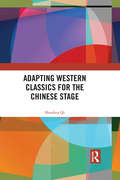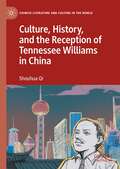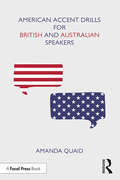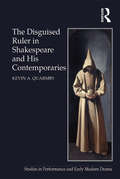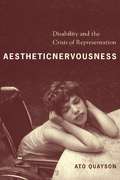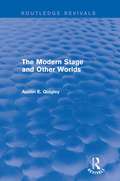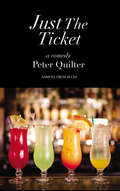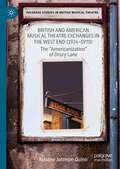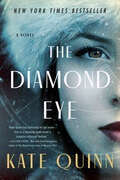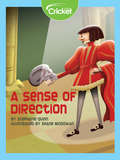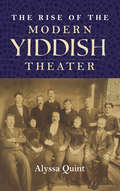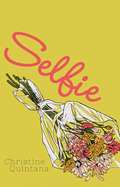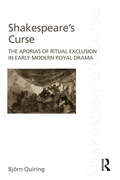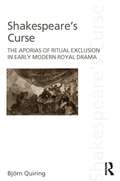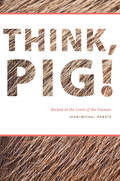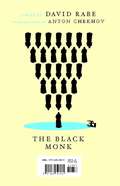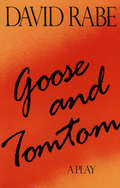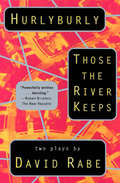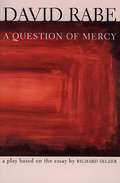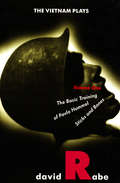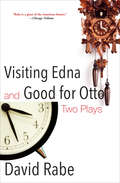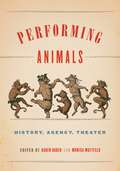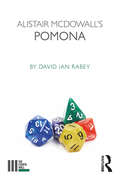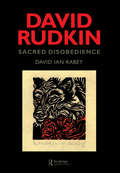- Table View
- List View
Adapting Western Classics for the Chinese Stage
by Shouhua QiAdapting Western Classics for the Chinese Stage presents a comprehensive study of transnational, transcultural, and translingual adaptations of Western classics from the turn of the twentieth century to present-day China in the age of globalization. Supported by a wide range of in-depth research, this book Examines the complex dynamics between texts, both dramatic and socio-historical; contexts, both domestic and international; and intertexts, Western classics and their Chinese reinterpretations in huaju and/or traditional Chinese xiqu; Contemplates Chinese adaptations of a range of Western dramatic works, including Greek, English, Russian, and French; Presents case studies of key Chinese adaptation endeavors, including the 1907 adaptation of Uncle Tom’s Cabin by the Spring Willow Society and the 1990 adaptation of Hamlet by Lin Zhaohua; Lays out a history of uneasy convergence of East and West, complicated by tensions between divergent sociopolitical forces and cultural proclivities. Drawing on disciplines and critical perspectives, including theatre and adaptation studies, comparative literature, translation studies, reception theory, post-colonialism, and intertextuality, this book is key reading for students and researchers in any of these fields.
Culture, History, and the Reception of Tennessee Williams in China (Chinese Literature and Culture in the World)
by Shouhua QiThis book is the first comprehensive study of the reception of Tennessee Williams in China, from rejection and/or misgivings to cautious curiosity and to full-throated acceptance, in the context of profound changes in China’s socioeconomic and cultural life and mores since the end of the Cultural Revolution. It fills a conspicuous gap in scholarship in the reception of one of the greatest American playwrights and joins book-length studies of Chinese reception of Shakespeare, Ibsen, O’Neill, Brecht, and other important Western playwrights whose works have been eagerly embraced and appropriated and have had catalytic impact on modern Chinese cultural life.
American Accent Drills for British and Australian Speakers
by Amanda QuaidAmerican Accent Drills for British and Australian Speakers provides a comprehensive guide to learning a "General American" accent, made specifically for native English speakers. Unlike most American accent guides, which are geared toward ESL learners, this handbook covers only the shifts that English speakers need to make – nothing more, nothing less. In addition to vowel and consonant drills, it covers the finer points of American intonation and elision, features that often elude English speakers of other dialects. Finally, it provides exercises for "owning" the dialect, finding authenticity and making it work for each individual actor in their own way. This is an excellent resource for students of speech and dialects, actors from the UK, Australia, and New Zealand, and advanced ESL learners who need to use an American accent on screen or on stage. American Accent Drills for British and Australian Speakers also includes access to downloadable audio files of the practice drills featured in the book, to help students practice and perfect their American accent.
The Disguised Ruler in Shakespeare and his Contemporaries (Studies in Performance and Early Modern Drama)
by Kevin A. QuarmbyIn the early seventeenth century, the London stage often portrayed a ruler covertly spying on his subjects. Traditionally deemed 'Jacobean disguised ruler plays', these works include Shakespeare's Measure for Measure, Marston's The Malcontent and The Fawn, Middleton's The Phoenix, and Sharpham's The Fleer. Commonly dated to the arrival of James I, these plays are typically viewed as synchronic commentaries on the Jacobean regime. Kevin A. Quarmby demonstrates that the disguised ruler motif actually evolved in the 1580s. It emerged from medieval folklore and balladry, Tudor Chronicle history and European tragicomedy. Familiar on the Elizabethan stage, these incognito rulers initially offered light-hearted, romantic entertainment, only to suffer a sinister transformation as England awaited its ageing queen's demise. The disguised royal had become a dangerously voyeuristic political entity by the time James assumed the throne. Traditional critical perspectives also disregard contemporary theatrical competition. Market demands shaped the repertories. Rivalry among playing companies guaranteed the motif's ongoing vitality. The disguised ruler's presence in a play reassured audiences; it also facilitated a subversive exploration of contemporary social and political issues. Gradually, the disguised ruler's dramatic currency faded, but the figure remained vibrant as an object of parody until the playhouses closed in the 1640s.
Aesthetic Nervousness: Disability and the Crisis of Representation
by Ato QuaysonFocusing primarily on the work of Samuel Beckett, Toni Morrison, Wole Soyinka, and J. M. Coetzee, Ato Quayson launches a thoroughly cross-cultural, interdisciplinary study of the representation of physical disability. Quayson suggests that the subliminal unease and moral panic invoked by the disabled is refracted within the structures of literature and literary discourse itself, a crisis he terms "aesthetic nervousness." The disabled reminds the able-bodied that the body is provisional and temporary and that normality is wrapped up in certain social frameworks. Quayson expands his argument by turning to Greek and Yoruba writings, African American and postcolonial literature, depictions of deformed characters in early modern England and the plays of Shakespeare, and children's films, among other texts. He considers how disability affects interpersonal relationships and forces the character and the reader to take an ethical standpoint, much like representations of violence, pain, and the sacred. The disabled are also used to represent social suffering, inadvertently obscuring their true hardships.
The Modern Stage and Other Worlds (Routledge Revivals)
by Austin E. QuigleyModern plays are strikingly diverse and, as a result, any attempt to locate an underlying unity between them encounters difficulties: to focus on what they have in common is often to overlook what is of primary importance in particular plays; to focus on their differences is to note the novelty of the plays without increasing their accessibility. In this study, first published in 1985, Austin E. Quigley takes as his paradigm case the relationship between the world of the stage and the world of the audience, and explores various modes of communication between domains. He asks how changes in the structure of the drama relate to changes in the structure of the theatre, and changes in the role of the audience. Detailed interpretations of plays by Pinero, Ibsen, Strindberg, Brecht, Ionesco, Beckett and Pinter question principles about the modern theatre and establish links between drama structure and theatre structure, theme, and performance space.
Just the Ticket
by Peter QuilterSusan, an eccentric sixty-year-old, decides to celebrate her birthday by repeating a journey to Australia she made with a group of friends when she was 20. This time, she’s travelling alone — carrying the same hopes and dreams, but with 40 years of extra baggage! Endlessly chatty, accident-prone and often looking like she’s been dragged through a hedge backwards, Susan is undoubtedly colourful. Her wit, charm, chaos and hint of sadness have given her a unique outlook on life — and make her an unforgettable character. Romance slowly but awkwardly blossoms as she reunites with Bill, the bartender at the hotel, an unexpected turn of events that causes Susan to reflect on life, love, loneliness, friendship and the trials and joys of growing older. Just the Ticket is a poignant 90-minute journey through Susan’s hilarious life.
British and American Musical Theatre Exchanges in the West End: The “Americanization” of Drury Lane (Palgrave Studies in British Musical Theatre)
by Arianne Johnson QuinnThis monograph centres on the history of musical theatre in a space of cultural significance for British identity, namely the Theatre Royal, Drury Lane, which housed many prominent American productions from 1924-1970. It argues that during this period Drury Lane was the site of cultural exchanges between Britain and the United States that were a direct result of global engagement in two world wars and the evolution of both countries as imperial powers. The critical and public response to works of musical theatre during this period, particularly the American musical, demonstrates the shifting response by the public to global conflict, the rise of an American Empire in the eyes of the British government, and the ongoing cultural debates about the role of Americans in British public life. By considering the status of Drury Lane as a key site of cultural and political exchanges between the United States and Britain, this study allows us to gain a more complete portrait of the musical’s cultural significance in Britain.
The Diamond Eye: A Novel
by Kate QuinnNew York Times BestsellerThe bestselling author of The Rose Code returns with an unforgettable World War II tale of a quiet bookworm who becomes history’s deadliest female sniper. Based on a true story.In 1937 in the snowbound city of Kyiv, wry and bookish history student Mila Pavlichenko organizes her life around her library job and her young son—but Hitler’s invasion of Ukraine and Russia sends her on a different path. Given a rifle and sent to join the fight, Mila must forge herself from studious girl to deadly sniper—a lethal hunter of Nazis known as Lady Death. When news of her three hundredth kill makes her a national heroine, Mila finds herself torn from the bloody battlefields of the eastern front and sent to America on a goodwill tour.Still reeling from war wounds and devastated by loss, Mila finds herself isolated and lonely in the glittering world of Washington, DC—until an unexpected friendship with First Lady Eleanor Roosevelt and an even more unexpected connection with a silent fellow sniper offer the possibility of happiness. But when an old enemy from Mila’s past joins forces with a deadly new foe lurking in the shadows, Lady Death finds herself battling her own demons and enemy bullets in the deadliest duel of her life.Based on a true story, The Diamond Eye is a haunting novel of heroism born of desperation, of a mother who became a soldier, of a woman who found her place in the world and changed the course of history forever.
A Sense of Direction
by Stephanie QuinnStage directions are instructions an actor follows in performing a play. They help the director tell the actors where to go on the stage.
The Rise of the Modern Yiddish Theater: Avrom Goldfaden And The Jewish Stage (Jews Of Eastern Europe Ser.)
by Alyssa QuintJewish Book Award Finalist: &“Turns the fascinating life of Avrom Goldfaden into a multi-dimensional history of the Yiddish theater&’s formative years.&” —Jeffery Veidinger, author of Jewish Public Culture in the Late Russian Empire In this book, Alyssa Quint focuses on the early years of the modern Yiddish theater, from roughly 1876 to 1883, through the works of one of its best-known and most colorful figures, Avrom Goldfaden. Goldfaden (né Goldenfaden, 1840-1908) was one of the first playwrights to stage a commercially viable Yiddish-language theater, first in Romania and then in Russia. Goldfaden&’s work was rapidly disseminated in print and his plays were performed frequently for Jewish audiences. Sholem Aleichem considered him as a forger of a new language that &“breathed the European spirit into our old jargon.&” Quint uses Goldfaden&’s theatrical works as a way to understand the social life of Jewish theater in Imperial Russia. Through a study of his libretti, she looks at the experiences of Russian Jewish actors, male and female, to explore connections between culture as artistic production and culture in the sense of broader social structures. Quint explores how Jewish actors who played Goldfaden&’s work on stage absorbed the theater into their everyday lives. Goldfaden&’s theater gives a rich view into the conduct, ideology, religion, and politics of Jews during an important moment in the history of late Imperial Russia.
Selfie
by Christine QuintanaA new year of high school is full of excitement and potential—but three teens didn’t expect it to bring such a dark change to their lives. After spending a summer reinventing herself in Paris, Emma is ready for her new life to start, while her best friend Lily is eager for them to reconnect. Lily throws a last-minute party fuelled by alcohol and Instagram, which leads to a long-awaited encounter between Emma and Lily’s older brother Chris. But the next day Emma feels that something went terribly wrong. When a doctor’s appointment and a visit from police confirm that there was a sexual assault at the party, and the whole school turns against Emma, the three friends grapple with what actually happened between Emma and Chris. This smart and intense play about the complexities of relationships and community opens up a much-needed conversation about the nature of consent.
Shakespeare's Curse
by Bjoern QuiringConceptualizing the curse as the representation of a foundational, mythical violence that is embedded within juridical discourse, Shakespeare’s Curse pursues a reading of Richard III, King John, and King Lear in order to analyse the persistence of imprecations in the discourses of modernity. Shakespeare wrote during a period that was transformative in the development of juridical thinking. However, taking up the relationship between theatre, theology and law, Bjoern Quiring argues that the curse was not eliminated from legal discourses during this modernization of jurisprudence; rather, it persisted and to this day continues to haunt numerous speech acts. Drawing on the work of Derrida, Lacan, Walter Benjamin and Giorgio Agamben, among others, Quiring analyses the performativity of the curse, and tracks its power through the juristic themes that are pursued within Shakespeare’s plays – such as sovereignty, legitimacy, succession, obligation, exception, and natural law. Thus, this book provides an original and important insight into early modern legal developments, as well as a fresh perspective on some of Shakespeare’s best-known works. A fascinating interdisciplinary study, this book will interest students and scholars of Law, Literature, and History.
Shakespeare's Curse: The Aporias of Ritual Exclusion in Early Modern Royal Drama
by Björn QuiringConceptualizing the curse as the representation of a foundational, mythical violence that is embedded within juridical discourse, Shakespeare’s Curse:The Aporias of Ritual Exclusion in Early Modern Royal Drama pursues a reading of Richard III, King John, and King Lear in order to analyse the persistence of imprecations in the discourses of modernity. Shakespeare wrote during a period that was transformative in the development of juridical thinking. However, taking up the relationship between theater, theology and law, Björn Quiring argues that the curse was not eliminated from legal discourses during this modernization of jurisprudence; rather, it persisted and to this day continues to haunt numerous speech acts. Drawing on the work of Derrida, Lacan, Walter Benjamin and Giorgio Agamben, among others, Quiring analyses the performativity of the curse, and tracks its power through the juristic themes that are pursued within Shakespeare’s plays – such as sovereignty, legitimacy, succession, obligation, exception, and natural law. Thus, this book provides an original and important insight into early modern legal developments, as well as a fresh perspective on some of Shakespeare’s best known works. A fascinating interdisciplinary study, this book will interest students and scholars of Law, Literature, and History.
Think, Pig!: Beckett at the Limit of the Human
by Jean-Michel RabatéThis book examines Samuel Beckett’s unique lesson in courage in the wake of humanism’s postwar crisis—the courage to go on living even after experiencing life as a series of catastrophes. Rabaté, a former president of the Samuel Beckett Society and a leading scholar of modernism, explores the whole range of Beckett’s plays, novels, and essays. He places Beckett in a vital philosophical conversation that runs from Bataille to Adorno, from Kant and Sade to Badiou. At the same time, he stresses Beckett’s inimitable sense of metaphysical comedy. Foregrounding Beckett’s decision to write in French, Rabaté inscribes him in a continental context marked by a “writing degree zero” while showing the prescience and ethical import of Beckett’s tendency to subvert the “human” through the theme of the animal. Beckett’s “declaration of inhuman rights,” he argues, offers the funniest mode of expression available to us today.
The Black Monk and The Dog Problem: Two Plays
by David RabeThe Black Monk has been called a singular "collaboration" between two writers: Anton Chekhov and David Rabe. Based on Chekov's novella of the same name, Rabe's brilliant stage adaptation tells the story of Kovrin, the young philosophy student who returns from Moscow to the estate owned by Pesotsky, where he spent his youth. Kovrin and Pesotsky's daughter, Tanya, soon fall in love and plan to marry. But the appearance of an emissary from the unknown -- the black monk -- threatens to have a devastating effect on all of them. Trouble starts in when Teresa tells her brother Joey that this guy Ray did something to her with his dog in bed. Nobody seems to know exactly what happened, but they do know that somebody's got to pay. So what is The Dog Problem? It starts with being born into a world where the wrong thing said to the wrong person ignites a chain reaction of misplaced passions and galloping sentences that race to a deadly conclusion. The playful title is revealed to be a wry pun on the Cartesian mind/body problem, as Uncle Mal, the aging mobster, must face his turn to be the dog in this darkly funny play about men, women, sex, betrayal, and ghosts. Vastly different in their aesthetic, these two recent and highly praised plays embody all of the celebrated hallmarks of David Rabe's writing and art: unflinchingly honest and perceptive themes, starkly luminous dialogue, and the unsettling humor that have made him an icon of the American theater for more than forty years.
Goose and Tomtom: A Play (Books That Changed the World)
by David Rabe&“[A] violent, surrealist romp&” from the Tony Award–winning playwright of Hurlyburly and Visiting Edna (The Brown Daily Herald). David Rabe explores the struggle between hope and anguish in the human spirit in this story of two small-time jewel thieves united in a strangely unsettling friendship and the constant fight to prove to themselves and others how tough they are. But when their frantic scheming suddenly begins to betray them in mysterious ways, they find themselves trapped into a kidnapping and a murder over which they seem to have no control. Or do they? David Rabe&’s language creates and recreates reality in constantly surprising ways, magically dramatizing the danger of the power of illusion—and the illusion of power—with force and insight. &“A potluck smorgasbord of surrealism, dream soliloquies, science fiction, noir potboiler and fairy tales, with the ghosts of such other writers as David Mamet, Harold Pinter, Sam Shepard and even novelist Thomas Pynchon hovering nearby . . . boasts ample proof of a top-notch writer at work.&” —Chicago Tribune &“A fast-paced, visceral work with a manic, anarchic energy . . . a chaotic examination of power and powerlessness in a frightening, irrational universe.&” —The Brown Daily Herald &“[A] surrealist, hilarious, mind-fuck of a play . . . a wild, high-energy ride through plot and action.&” —LAist Praise for David Rabe &“Few contemporary dramatists have dealt with violence, physical and psychological, more impressively than Rabe.&” —Kirkus Reviews &“A remarkable storyteller.&” —Chicago Tribune &“Rabe&’s mastery of dialogue is the equal of Pinter and Mamet put together.&” —The Boston Globe.
Hurlyburly and Those the River Keeps: Two Plays (Books That Changed the World)
by David RabeThe landmark American play—and its prequel—from the Tony Award–winning author of Sticks and Bones and In the Boom Boom Room. Nominated for the Tony Award when it was first produced in 1984, Hurlyburly was immediately hailed as a classic American drama. This edition is the definitive version of David Rabe&’s most celebrated work, reflecting his continued exploration of the play through several productions—in particular the one he directed in 1988 at the Westwood Playhouse in Los Angeles—and his latest thoughts regarding the text. With Those the River Keeps, the prize-winning playwright embarks on an intense psychological exploration of Hurlyburly&’s most dangerous and enigmatic character. This edition contains the definitive versions of these works, a foreword in which Rabe examines the interwoven relationship of the plays, and an afterword in which he discusses the process of their construction. &“Fresh, glittering, entertaining, full of wit and blisteringly funny. A stunning comic drama of contemporary life in the Hollywood hills and beyond.&” —USA Today &“Powerfully written . . . dazzling.&” —The New Republic &“Offers some of Rabe&’s most inventive writing.&” —The New York Times &“Compelling . . . Those the River Keeps&’ strength is its dialogue, which ranges from staccato nonsense to amorphous bursts of palooka philosophy and raw anguish . . . masterfully rendered.&” —The Boston Phoenix Praise for David Rabe &“Few contemporary dramatists have dealt with violence, physical and psychological, more impressively than Rabe.&” —Kirkus Reviews &“A remarkable storyteller.&” —Chicago Tribune &“Rabe&’s mastery of dialogue is the equal of Pinter and Mamet put together.&” —The Boston Globe
A Question of Mercy: A Play Based on the Essay by Richard Selzer (Books That Changed the World)
by David RabeThe Tony Award–winning playwright of Hurlyburly &“confronts the timely topic of assisted suicide . . . an affirmation of dignity that rings clear and true&” (Variety). David Rabe is one of America&’s finest dramatists. In A Question of Mercy, he explores the controversial and emotional issue of euthanasia, delving deep into the ties that bind friends and lovers. Thomas and Anthony are lovers struggling with Anthony&’s final, exhausting battle with AIDS. Joined by their friend Susanah and a retired doctor, whose help Thomas has requested, they fashion a heartbreaking friendship as they work through the stages of a plan to relieve Anthony of his illness and his life. Rabe creates a passionate depiction of four people confronted with the reality of a loved one&’s fight with death and a compelling dramatic event that poses the question: &“What would you do?&” &“A moving and enlightening experience.&” —Backstage &“Completely gripping. This life and death tale questions the moral implications involved with assisted suicide, and the honor behind the action. A serious and provocative night at the theatre.&” —Theasy Praise for David Rabe &“Few contemporary dramatists have dealt with violence, physical and psychological, more impressively than Rabe.&” —Kirkus Reviews &“A remarkable storyteller.&” —Chicago Tribune &“Rabe&’s mastery of dialogue is the equal of Pinter and Mamet put together . . . full of a measured Mafia formality played against Jacobean terrors, blood lust, horror and revenge raised to an unlikely poetry dazed by equally unlikely insights.&” —The Boston Globe
The Vietnam Plays: The Basic Training of Pavlo Hummel and Sticks and Bones (Books That Changed the World)
by David Rabe&“The only Vietnam plays to appear on Broadway while the war was raging&” from the Tony Award–winning playwright of Hurlyburly (Observer). David Rabe has been a major voice and crucial force in American drama since 1971 when, in the midst of the Vietnam War, he startled the nation with The Basic Training of Pavlo Hummel. The story of a native recruit&’s initiation into war, it is by turns brutal and hilarious. It won the young playwright an Obie and was hailed by The New York Times as &“rich humor, irony, and insight.&” More than four decades later, Rabe continues to be one of our most compelling dramatists. In this, the first of two volumes of The Vietnam Plays, Pavlo Hummel is paired with the equally intense Sticks and Bones, in which a blinded Vietnam veteran returns home numbed by the war and is astonished by his family&’s inability to comprehend their country&’s politics and his rage. &“Pavlo won Al Pacino a Tony, and Sticks and Bones won one for its Harriet, Elizabeth Wilson—plus a nomination for its Oz, Tom Aldredge. It also won the Best Play Tony&” (Observer). &“Defies a million slogans to become a contemporary masterpiece.&” —The Harvard Crimson on The Basic Training of Pavlo Hummel &“Sticks and Bones is still a searing critique of America&’s willful ignorance in the face of an ultra-violent international war machine operating in our name.&” —TheaterMania &“This scalding work scores direct hits on the stubborn obliviousness of the folks back home to the realities of that dirtiest of 20th century wars.&” —The Hollywood Reporter on Sticks and Bones
Visiting Edna and Good for Otto: Two Plays
by David RabeTwo plays exploring the struggle of mental illness by the Tony Award–winning “giant of American theater” and author of Hurlyburly (Chicago Tribune). Good for Otto, which premiered in October 2015 at the Gift Theatre in Chicago, is a “sprawling drama of mental illness” in which “Mr. Rabe digs into his subject with a depth that almost feels bottomless.” Drawing on material from Undoing Depression by psychotherapist Richard O’Connor, it explores the lives of a therapist and his many patients, all trying to navigate personal trauma (Charles Isherwood, The New York Times). Visiting Edna, which premiered in September 2016 at the Steppenwolf Theatre in Chicago, is a drama of “deeply searing power” about the bond between mother and son. As Edna faces a short future plagued by her many illnesses—and a cancer that looms so large it becomes another character—she and her adult son struggle to communicate about their shared past as they contemplate the future (Variety). Taken together, the plays offer a satisfying glimpse into “Rabe’s theatrical universe . . . at once vivid and mysterious, a pageant and a puzzle” of contemporary American life (John Lahr, The New Yorker). “Many would list [Rabe] among the very greatest of living playwrights.” —Chris Jones, Chicago Tribune
Performing Animals: History, Agency, Theater (Animalibus: Of Animals and Cultures #11)
by Karen Raber Monica MattfeldFrom bears on the Renaissance stage to the equine pageantry of the nineteenth-century hunt, animals have been used in human-orchestrated entertainments throughout history. The essays in this volume present an array of case studies that inspire new ways of interpreting animal performance and the role of animal agency in the performing relationship.In exploring the human-animal relationship from the early modern period to the nineteenth century, Performing Animals questions what it means for an animal to “perform,” examines how conceptions or this relationship have evolved over time, and explores whether and how human understanding of performance is changed by an animal’s presence. The contributors discuss the role of animals in venues as varied as medieval plays, natural histories, dissections, and banquets, and they raise provocative questions about animals’ agency. In so doing, they demonstrate the innovative potential of thinking beyond the boundaries of the present in order to dismantle the barriers that have traditionally divided human from animal.From fleas to warhorses to animals that “perform” even after death, this delightfully varied volume brings together examples of animals made to “act” in ways that challenge obvious notions of performance. The result is an eye-opening exploration of human-animal relationships and identity that will appeal greatly to scholars and students of animal studies, performance studies, and posthuman studies.In addition to the editors, the contributors are Todd Andrew Borlik, Pia F. Cuneo, Kim Marra, Richard Nash, Sarah E. Parker, Rob Wakeman, Kari Weil, and Jessica Wolfe.
Performing Animals: History, Agency, Theater (Animalibus)
by Karen Raber Monica MattfeldFrom bears on the Renaissance stage to the equine pageantry of the nineteenth-century hunt, animals have been used in human-orchestrated entertainments throughout history. The essays in this volume present an array of case studies that inspire new ways of interpreting animal performance and the role of animal agency in the performing relationship.In exploring the human-animal relationship from the early modern period to the nineteenth century, Performing Animals questions what it means for an animal to “perform,” examines how conceptions of this relationship have evolved over time, and explores whether and how human understanding of performance is changed by an animal’s presence. The contributors discuss the role of animals in venues as varied as medieval plays, natural histories, dissections, and banquets, and they raise provocative questions about animals’ agency. In so doing, they demonstrate the innovative potential of thinking beyond the boundaries of the present in order to dismantle the barriers that have traditionally divided human from animal.From fleas to warhorses to animals that “perform” even after death, this delightfully varied volume brings together examples of animals made to “act” in ways that challenge obvious notions of performance. The result is an eye-opening exploration of human-animal relationships and identity that will appeal greatly to scholars and students of animal studies, performance studies, and posthuman studies.In addition to the editors, the contributors are Todd Andrew Borlik, Pia F. Cuneo, Kim Marra, Richard Nash, Sarah E. Parker, Rob Wakeman, Kari Weil, and Jessica Wolfe.
Alistair McDowall's Pomona (The Fourth Wall)
by David Ian Rabey‘It’s all real. All of it. Everything bad is real’ - Moe Alistair McDowall’s Pomona was first staged in 2014 and won properly startling, and startled, acclaim. Its edgeland setting permits a surrealistic disengagement of linear forms of time, which is both dreamlike and wildly funny; nightmarish and ominously enveloping. The play has as its imaginative springboard a landscape which is both real and surreal. It offers an unforgettable journey into radical uncertainty, alongside unpredictable action that presents and questions the forms by which all too much of British life is lived. Rabey offers us a wild plunge into this modern English urban rabbit hole, a haunting and bewildering high-stakes hunt for meaning and value, set in a gothic noir Manchester, possibly dystopian (or possibly not).
David Rudkin: An Expository Study of his Drama 1959-1994
by David Ian Rabey David I. RabeyDr. Rabey's profound critical study of David Rudkin's drama constitutes an in-depth evaluation of this unique dramatist, re-assessed in the light of his bi-sexuality and Anglo-Irish origins. This key study includes insights from noted performers of Rudkin's work, including Ian Hogg, Peter McEnery, Ian McDiarmid, Gerard Murphy, and Charlotte Cornwell. It is a fully authorized study with exclusive reference to archival material which includes some frank and urgent interview contributions from the dramatist himself, who is usually deemed reclusive. It is enhanced by Dr. Rabey's own experience of Wales, Ireland, and the English Black Country for his exposition of Rudkin's mythic sense of Celtic and Mercian history.
